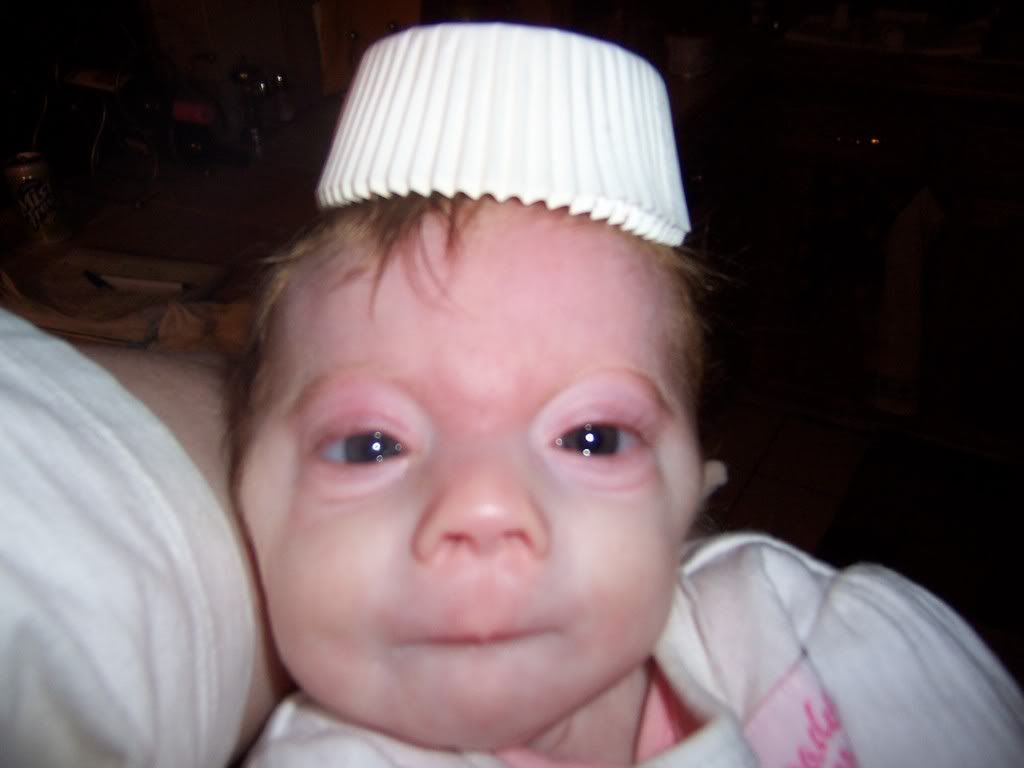
 (Hope, meet Gavin. Five and a half pound baby, meet nine pound baby. Slobbering ensues.)
(Hope, meet Gavin. Five and a half pound baby, meet nine pound baby. Slobbering ensues.)We're becoming guinea pigs. It's nothing to aspire to. If you think about it too hard, it's glum reminder of what rare, freaky straits we find ourselves in. But it could do a lot of good.
Even though Hope was diagnosed a few weeks ago with Cornelia de Lange Syndrome, we are proceeding with blood tests to confirm it -- a process that could pinpoint the specific gene that went awry to give the syndrome to Hope and
Will.
We're enlisting in a study by
Children's Hospital of Philadelphia of families with multiple CdLS children. Hope's blood first will be analyzed in hopes of finding the gene. If it is, they will follow with blood from Will that we banked when he died.
We've had chats about entering the study. On the surface, it seems redundant. We instinctively want to protect Hope. Drawing her blood to map her genomes and sharing those results with the medical world seems like the ultimate intrusion.
But the potential benefits outweigh those qualms. Foremost, it could further understanding of a condition we wish didn't exist. It also could assist us if we roll the dice with future pregnancies.
Research is moving swiftly, but it's still mostly a small-scale operation run largely from Children's Hospital of Philadelphia. There's simply not that many kids out there; it's thought to affect 1 in 10,000-100,000 live births.
And there are far fewer families with more than one CdLS child. Supposedly, 1-2 percent have multiple children with the syndrome. But it's a bit like lightning striking twice. Caused by one gene mutating and not forming correctly during conception, CdLS is a
dominant condition. That means if you have the gene, you have CdLS. Neither Mo nor I do.
There's a complicated explanation for why this would happen twice called
germline mosaicism that involves a problem during
meiosos, the process of cell division in sexual reproduction.
That's a tough concept to wrap your head around. Mo summed it up best when she said, "One of us is kicking out some messed up sperms or eggs."
The tests to find the gene are being run by Dr. Ian Krantz of Children's Hospital. He is one of two scientists in the past few years to isolate the cause of CdLS to three genes among the
30,000 or so we all have. One or the other is all it takes to cause CdLS: All are located on the fifth chromosome of the 46 that form life.
The test is hardly a sure thing. Common syndromes like Down Syndrome are easy to confirm at a microscopic level because they involve an entire missing or extra chromosome. Kids with CdLS have the correct number of chromosomes, but one bad gene within one of the 46.
The difference is like looking at a house from a satellite. Finding Down is like noticing it's missing a wall. Finding CdLS is like peering through the window, going around a wall, opening a door and noticing the missing sock under the bed.
And the results may not give us much comfort. The tests are able to find the gene only about half the time. When they do, they usually find a gene linked to classic CdLS, a more severe variety associated with greater retardation. There's a small chance of finding a gene that causes the milder strain.
Failure to find the gene means nothing. Hope still has CdLS.
But the payoff could be great. We'd like to have another child. Everything we've read or heard leads us to believe that children with CdLS do far better with siblings they can mimic and learn from. And it would help us too. We still crave those rich, mundane passages like soccer practice, spelling bees and junior proms that we may not get to experience with Hope.
Finding the gene could help our odds. Our crash course in genetics has taught us that, no matter how bad the condition, the worst odds of recurrence are 50/50. Ours are presumably more than 2 percent and less than 50.















